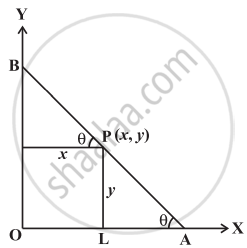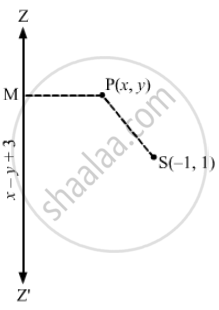Advertisements
Advertisements
प्रश्न
A bar of given length moves with its extremities on two fixed straight lines at right angles. Any point of the bar describes an ellipse.
विकल्प
True
False
उत्तर
This statement is True.
Explanation:
Let P (x, y) be any point on the bar such that PA = a and PB = b
Clearly from the figure
x = OL = b cosθ
y = PL = a sinθ
These give `x^2/b^2 + y^2/a^2` = 1
Which is an ellipse.
APPEARS IN
संबंधित प्रश्न
Find the equation for the ellipse that satisfies the given condition:
Vertices (±5, 0), foci (±4, 0)
Find the equation for the ellipse that satisfies the given conditions:
Vertices (0, ±13), foci (0, ±5)
Find the equation for the ellipse that satisfies the given conditions:
Vertices (±6, 0), foci (±4, 0)
Find the equation for the ellipse that satisfies the given conditions:
Ends of major axis (±3, 0), ends of minor axis (0, ±2)
Find the equation for the ellipse that satisfies the given conditions:
Ends of major axis (0, `+- sqrt5`), ends of minor axis (±1, 0)
Find the equation for the ellipse that satisfies the given conditions:
Centre at (0, 0), major axis on the y-axis and passes through the points (3, 2) and (1, 6)
Find the equation for the ellipse that satisfies the given conditions:
Major axis on the x-axis and passes through the points (4, 3) and (6, 2).
A man running a racecourse notes that the sum of the distances from the two flag posts form him is always 10 m and the distance between the flag posts is 8 m. find the equation of the posts traced by the man.
Find the equation of the ellipse in the case:
focus is (0, 1), directrix is x + y = 0 and e = \[\frac{1}{2}\] .
Find the equation of the ellipse in the case:
focus is (−2, 3), directrix is 2x + 3y + 4 = 0 and e = \[\frac{4}{5}\]
Find the equation of the ellipse in the case:
focus is (1, 2), directrix is 3x + 4y − 5 = 0 and e = \[\frac{1}{2}\]

Find the equation to the ellipse (referred to its axes as the axes of x and y respectively) which passes through the point (−3, 1) and has eccentricity \[\sqrt{\frac{2}{5}}\]
Find the equation of the ellipse in the case:
eccentricity e = \[\frac{1}{2}\] and foci (± 2, 0)
Find the equation of the ellipse in the case:
eccentricity e = \[\frac{2}{3}\] and length of latus rectum = 5
Find the equation of the ellipse in the case:
eccentricity e = \[\frac{1}{2}\] and semi-major axis = 4
Find the equation of the ellipse in the case:
eccentricity e = \[\frac{1}{2}\] and major axis = 12
Find the equation of the ellipse in the case:
The ellipse passes through (1, 4) and (−6, 1).
Find the equation of the ellipse in the case:
Vertices (± 5, 0), foci (± 4, 0)
Find the equation of the ellipse in the case:
Vertices (0, ± 13), foci (0, ± 5)
Find the equation of the ellipse in the following case:
Ends of major axis (0, ±\[\sqrt{5}\] ends of minor axis (± 1, 0)
Find the equation of the ellipse in the following case:
Length of major axis 26, foci (± 5, 0)
Find the equation of the ellipse in the following case:
Length of minor axis 16 foci (0, ± 6)
If P is a point on the ellipse `x^2/16 + y^2/25` = 1 whose foci are S and S′, then PS + PS′ = 8.
The line 2x + 3y = 12 touches the ellipse `x^2/9 + y^2/4` = 2 at the point (3, 2).
The equation of the ellipse having foci (0, 1), (0, –1) and minor axis of length 1 is ______.
